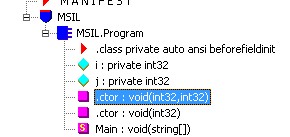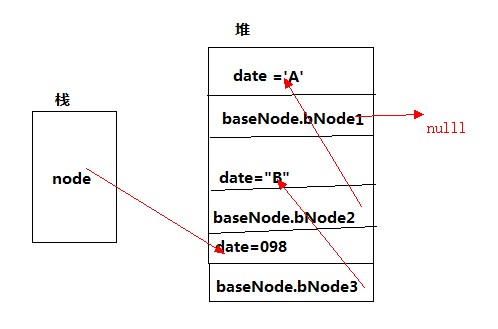一个类继承自另外一个类,他们的构造函数改怎么办?
首先必须先声明:构造函数是不能继承的
我们先看一段代码:第一段代码没有构造函数,第二段有一个,第三段有两个。从他们的MSIL可以看出,有几个构造函数就有几个.ctor的il函数。
即使你没有构造函数,编译器也会调用一个空的构造函数。让我们仔细瞧瞧MSIL代码:
我们可以看到每个IL中都有 instance void [mscorlib]System.Object::.ctor()
由此我们可以得出。不管你有几个构造器,你都必须执行父类的构造函数,才能执行当前构造函数;同样对于继承,必须先实现父类的构造函数,才能执行自己的.ctor
如果我们写一个空的构造函数 public class someType{ public someType(){ } }
就是public class someType{ public someType():base(){ } } 。这种方法是调用(基)类中其他的构造器
 (方法一,二 都只有一个.ctor)
(方法一,二 都只有一个.ctor) (方法三:有两个.ctor)
(方法三:有两个.ctor)
static void Main(string[] args)
{
Console.WriteLine("nihao");
}
.method public hidebysig specialname rtspecialname
instance void .ctor() cil managed
{
// 代码大小 7 (0x7)
.maxstack 8
IL_0000: ldarg.0
IL_0001: call instance void [mscorlib]System.Object::.ctor()
IL_0006: ret
} // end of method Program::.ctor
class Program
{
private Int32 i;
public Program(Int32 i)
{
this.i = i;
}
static void Main(string[] args)
{
Console.WriteLine("nihao");
}
}
.method public hidebysig specialname rtspecialname
instance void .ctor(int32 i) cil managed
{
// 代码大小 17 (0x11)
.maxstack 8
IL_0000: ldarg.0
IL_0001: call instance void [mscorlib]System.Object::.ctor()
IL_0006: nop
IL_0007: nop
IL_0008: ldarg.0
IL_0009: ldarg.1
IL_000a: stfld int32 MSIL.Program::i
IL_000f: nop
IL_0010: ret
} // end of method Program::.ctor
class Program
{
private Int32 i;
private Int32 j;
public Program(Int32 i)
{
this.i = i;
}
public Program(Int32 i, Int32 j)
{
this.i = i;
this.j = j;
}
static void Main(string[] args)
{
Console.WriteLine("nihao");
}
}
.method public hidebysig specialname rtspecialname
instance void .ctor(int32 i,
int32 j) cil managed
{
// 代码大小 24 (0x18)
.maxstack 8
IL_0000: ldarg.0
IL_0001: call instance void [mscorlib]System.Object::.ctor()
IL_0006: nop
IL_0007: nop
IL_0008: ldarg.0
IL_0009: ldarg.1
IL_000a: stfld int32 MSIL.Program::i
IL_000f: ldarg.0
IL_0010: ldarg.2
IL_0011: stfld int32 MSIL.Program::j
IL_0016: nop
IL_0017: ret
} // end of method Program::.ctor
.method public hidebysig specialname rtspecialname
instance void .ctor(int32 i) cil managed
{
// 代码大小 17 (0x11)
.maxstack 8
IL_0000: ldarg.0
IL_0001: call instance void [mscorlib]System.Object::.ctor()
IL_0006: nop
IL_0007: nop
IL_0008: ldarg.0
IL_0009: ldarg.1
IL_000a: stfld int32 MSIL.Program::i
IL_000f: nop
IL_0010: ret
} // end of method Program::.ctor
首先我们看看一个关于this()/base() 也就是本构造器调用其他构造器的例子,注意调用其他构造器在前,再执行自己的代码
class Program
{
private Int32 i;
private Int32 j;
private string m;
public Program() //初始化所有变量
{
this.i = 1;
this.j = 2;
this.m = "nimei";
}
public Program(Int32 i):this() //构造单个变量
{
this.i = i;
}
public Program(Int32 j): this()
{
this.i = j;
}
public Program(string m): this()
{
this.m = m;
}
static void Main(string[] args)
{
Console.WriteLine("nihao");
}
}
三、接下来贴出搞了我一下午的一个例子。在上篇博客中讲到用范型实现一个链表。但是那种实现方式中,链表的每个值必须都是同一个类型,本例中实现任意类型
直接贴代码,下面解释
public class baseNode {
protected baseNode bNode;
public baseNode(baseNode bn)
{
this.bNode = bn;
}
}
public class Node2<T>:baseNode
{
private T _data;
public Node2(T data):this(data,null) //:base(null) 注意在构造之前要实现父类的构造函数
{
this._data = data;
}
public Node2(T data,baseNode bNode):base(bNode)
{
this._data = data;
}
public override string ToString()
{
return _data.ToString() + (bNode != null ? bNode.ToString() : null);
}
}
public class LeaderFunction2
{
public void function()
{
baseNode node = new Node2<char>('A');
node = new Node2<string>("B", node);
node = new Node2<Int32>(3354435, node);
node = new Node2<char>('D', node);
node = new Node2<char>('E', node);
Console.WriteLine(node.ToString());
Console.ReadKey();
}
}
这个例子理解了一下午,搞不懂其内部机制,想用MSIL解释,看到那些伪汇编头都大,主要是由于自己的基础知识不扎实啊!
本例中:第一,注意继承要实现父类的构造
第二,为什么这样写可以实现:

其实还是和之前的一样,虽然到了最后node指向最后一个 NOde2对象,但是之前的对象都没有销毁,地址保存在下个node2中的basenode.bNodeN中。